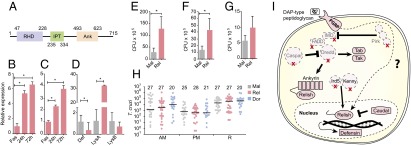Fig. 2.
Characterization of IMD pathway and control of T. cruzi replication. Although several proteins from the IMD pathway are missing from the R. prolixus genome, the pathway is still active. (A) The rpRelish protein contains a Rel homology domain (RHD), an Ig-like fold, Plexins, a transcription factor domain (IPT), and several ankyrin (Ank) domains. (B and C) In response to the growth of the native microbiota following a blood meal, rpRelish expression is increased at 24 and 72 h postblood meal in both the midgut (B) and fat body (C). Fas: fasting. When rpRelish expression is knocked down (pink) in the gut using RNAi (SI Appendix, Fig. A6B), the expression of defensin A (Def) is greatly reduced, and the expression of lysozyme A (LizA) is increased (D). Upon knockdown of rpRelish expression (pink), the bacteria load in the anterior midgut (AM) (E) and posterior midgut (PM) (F) is increased, with the same trend observed in the rectum (R) (G). dsMal control was shown in gray, *P < 0.05. Upon knockdown of rpDorsal or rpRelish expressions (SI Appendix, Fig. A6), T. cruzi levels are not altered in any section of the digestive tract 14 d after infection (H). dsMal control (gray), dsRelish (pink) and dsDorsal (blue). Median values are at the graphic top. (I) Representation of the IMD R. prolixus immune pathways depicting the absence of key IMD pathway components. In R. prolixus, although the Toll and Jak/STAT pathways are usually highly conserved, members of IMD pathway are missing (dashed lines shapes with red “X”), including the IMD, Fadd, and Dredd genes and the negative modulators Pirk (poor IMD response upon knock-in) and Caspar. However, the pathway receptors, PGRPs and a homolog of the transcription factor Relish (rpRelish) are present, suggesting that the activity of the pathway is exerted through a noncanonical mechanism.

